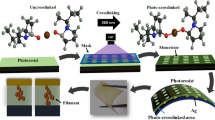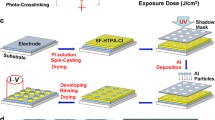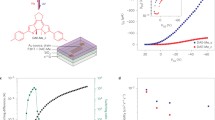Abstract
Organic memories typically comprise memristive polymer mediums sandwiched between two electrodes, with the advantages of wet manufacturing and modulated function. However, the issues associated with structural instability, low-speed switch, and hard pattern in polymeric memories are the main obstacles towards practical uses. Here, we present an ultrastable and fast-speed memory array that uses amorphous polymer nanofilm with light-/steam-driven crosslinked porous multistructure as memristive materials. The polymer diode shows nonvolatile rewritable flash memory characteristics, with a high ON/OFF ratio, long retention time, and high speeds of set (70 ns) and reset (845 ns) operations. Impressively, the memory cell undergoes harsh conditions in ultraviolet irradiation and extreme temperatures. By rationally integrating the array with target sensors, an artificial sensory memory architecture is constructed to mimic visual/thermal perception and recording, demonstrating great potential for biomimetic neuromorphic electronics. Our results advance a commercial perspective on memristive organics capable of integration patterns and high performance.
摘要
有机阻变存 储器由两个电极及夹在其间的阻变聚合物层组成, 具有湿法制备和功能可调的优点. 然而, 该类存储器还存在结构稳定性差、开关速度慢和图案化困难等问题. 在本文中, 我们利用光/蒸汽协同方法制备了一种具有交联多孔复合结构的非晶态聚合物薄膜, 并将其作为阻变活性材料构建了一种具有高稳定性和高读取速度特征的存储阵列. 所制备的聚合物二极管表现出非易失性的FLASH存储特性, 具有高开关比、长维持时间以及快速信息写入(70 ns)和擦除(845 ns)等特征. 令人印象深刻的是, 该存储器件能够承受紫外辐射和极端温度等恶劣环境的考验. 通过将存储阵列和特定传感器集成, 构建了能模拟视觉/热感知和记忆功能的人造感知记忆系统, 表明该系统在仿生神经形态电子领域具有巨大的应用潜力. 该工作为制备具有高稳定性和高读取速度特征的聚合物存储阵列提供了一种可靠的策略.

Similar content being viewed by others
References
Xia Q, Yang JJ. Memristive crossbar arrays for brain-inspired computing. Nat Mater, 2019, 18: 309–323
van de Burgt Y, Melianas A, Keene ST, et al. Organic electronics for neuromorphic computing. Nat Electron, 2018, 1: 386–397
Wu C, Kim TW, Choi HY, et al. Flexible three-dimensional artificial synapse networks with correlated learning and trainable memory capability. Nat Commun, 2017, 8: 752
Goswami S, Matula AJ, Rath SP, et al. Robust resistive memory devices using solution-processable metal-coordinated azo aromatics. Nat Mater, 2017, 16: 1216–1224
Sangwan VK, Hersam MC. Neuromorphic nanoelectronic materials. Nat Nanotechnol, 2020, 15: 517–528
Li Y, Qian Q, Zhu X, et al. Recent advances in organic-based materials for resistive memory applications. InfoMat, 2020, 2: 995–1033
Li Y, Zhang C, Shi Z, et al. Recent advances on crystalline materials-based flexible memristors for data storage and neuromorphic applications. Sci China Mater, 2022, 65: 2110–2127
Lenz T, Ghittorelli M, Benneckendorf FS, et al. Downscaling and charge transport in nanostructured ferroelectric memory diodes fabricated by solution micromolding. Adv Funct Mater, 2016, 26: 5111–5119
Chen Q, Wang Z, Lin M, et al. Homogeneous 3D vertical integration of parylene-C based organic flexible resistive memory on standard CMOS platform. Adv Electron Mater, 2021, 7: 2000864
Yang D, Yang H, Guo X, et al. Robust polyethylenimine electrolyte for high performance and thermally stable atomic switch memristors. Adv Funct Mater, 2020, 30: 2004514
Xu X, Zhou X, Wang T, et al. Robust DNA-bridged memristor for textile chips. Angew Chem Int Ed, 2020, 59: 12762–12768
Zhou L, Mao J, Ren Y, et al. Recent advances of flexible data storage devices based on organic nanoscaled materials. Small, 2018, 14: 1703126
Park SP, Tak YJ, Kim HJ, et al. Analysis of the bipolar resistive switching behavior of a biocompatible glucose film for resistive random access memory. Adv Mater, 2018, 30: 1800722
Goswami S, Deb D, Tempez A, et al. Nanometer-scale uniform conductance switching in molecular memristors. Adv Mater, 2020, 32: 2004370
Kang SK, Koo J, Lee YK, et al. Advanced materials and devices for bioresorbable electronics. Acc Chem Res, 2018, 51: 988–998
Li Y, Zhang C, Ling S, et al. Toward highly robust nonvolatile multilevel memory by fine tuning of the nanostructural crystalline solid-state order. Small, 2021, 17: 2100102
Zhou J, Li W, Chen Y, et al. A monochloro copper phthalocyanine memristor with high-temperature resilience for electronic synapse applications. Adv Mater, 2021, 33: 2006201
Lee EK, Lee MY, Park CH, et al. Toward environmentally robust organic electronics: Approaches and applications. Adv Mater, 2017, 29: 1703638
Tiwari K, Sarkar P, Modak S, et al. Large area self-assembled ultrathin polyimine nanofilms formed at the liquid-liquid interface used for molecular separation. Adv Mater, 2020, 32: 1905621
Liu J, Yang F, Cao L, et al. A robust nonvolatile resistive memory device based on a freestanding ultrathin 2D imine polymer film. Adv Mater, 2019, 31: 1902264
Liang B, Wang H, Shi X, et al. Microporous membranes comprising conjugated polymers with rigid backbones enable ultrafast organic-solvent nanofiltration. Nat Chem, 2018, 10: 961–967
Sahabudeen H, Qi H, Glatz BA, et al. Wafer-sized multifunctional polyimine-based two-dimensional conjugated polymers with high mechanical stiffness. Nat Commun, 2016, 7: 13461
Luo S, Zeng Z, Zeng G, et al. Recent advances in conjugated microporous polymers for photocatalysis: Designs, applications, and prospects. J Mater Chem A, 2020, 8: 6434–6470
Kim HJ, Park TH, Yoon KJ, et al. Fabrication of a Cu-cone-shaped cation source inserted conductive bridge random access memory and its improved switching reliability. Adv Funct Mater, 2019, 29: 1806278
Li W, Song X, Zhao X, et al. Design of wafer-scale uniform Au nanotip array by ion irradiation for enhanced single conductive filament resistive switching. Nano Energy, 2020, 67: 104213
Wu C, Kim TW, Guo T, et al. Mimicking classical conditioning based on a single flexible memristor. Adv Mater, 2017, 29: 1602890
Shin KY, Kim Y, Antolinez FV, et al. Controllable formation of nanofilaments in resistive memories via tip-enhanced electric fields. Adv Electron Mater, 2016, 2: 1600233
Zhang F, Qu G, Mohammadi E, et al. Solution-processed nanoporous organic semiconductor thin films: Toward health and environmental monitoring of volatile markers. Adv Funct Mater, 2017, 27: 1701117
Ling H, Yi M, Nagai M, et al. Controllable organic resistive switching achieved by one-step integration of cone-shaped contact. Adv Mater, 2017, 29: 1701333
Zhang X, Wang B, Huang L, et al. Breath figure-derived porous semiconducting films for organic electronics. Sci Adv, 2020, 6: eaaz1042
Toh CT, Zhang H, Lin J, et al. Synthesis and properties of free-standing monolayer amorphous carbon. Nature, 2020, 577: 199–203
Guan YS, Thukral A, Zhang S, et al. Air/water interfacial assembled rubbery semiconducting nanofilm for fully rubbery integrated electronics. Sci Adv, 2020, 6: eabb3656
Dong R, Zhang T, Feng X. Interface-assisted synthesis of 2D materials: Trend and challenges. Chem Rev, 2018, 118: 6189–6235
Liu Z, Yin Y, Xiu F, et al. Large-area patterned 2D conjugated microporous polymers via photomask-assisted solid-state photopolymerization. J Mater Chem C, 2018, 6: 7295–7301
Kimoto A, Cho JS, Ito K, et al. Novel hole-transport material for efficient polymer light-emitting diodes by photoreaction. Macromol Rapid Commun, 2005, 26: 597–601
Liu Z, Song M, Ju S, et al. Wafer-scale ultrathin two-dimensional conjugated microporous polymers: Preparation and application in heterostructure devices. ACS Appl Mater Interfaces, 2018, 10: 4010–4017
Yin Y, Liu Z, Song M, et al. Direct photopolymerization and lithography of multilayer conjugated polymer nanofilms for high performance memristors. J Mater Chem C, 2018, 6: 11162–11169
Gu C, Huang N, Gao J, et al. Controlled synthesis of conjugated microporous polymer films: Versatile platforms for highly sensitive and label-free chemo- and biosensing. Angew Chem, 2014, 126: 4950–4955
Wang X, Zhou Z, Ban C, et al. Multifunctional polymer memory via biinterfacial topography for pressure perception recognition. Adv Sci, 2020, 7: 1902864
Lai YS, Tu CH, Kwong DL, et al. Charge-transport characteristics in bistable resistive poly(N-vinylcarbazole) films. IEEE Electron Device Lett, 2006, 27: 451–453
Tseng RJ, Baker CO, Shedd B, et al. Charge transfer effect in the polyaniline-gold nanoparticle memory system. Appl Phys Lett, 2007, 90: 053101
Ling QD, Kang ET, Neoh KG, et al. Thermally stable polymer memory devices based on a π-conjugated triad. Appl Phys Lett, 2008, 92: 143302
Kim K, Park S, Hahm SG, et al. Nonvolatile unipolar and bipolar bistable memory characteristics of a high temperature polyimide bearing diphenylaminobenzylidenylimine moieties. J Phys Chem B, 2009, 113: 9143–9150
Kim DM, Park S, Lee TJ, et al. Programmable permanent data storage characteristics of nanoscale thin films of a thermally stable aromatic polyimide. Langmuir, 2009, 25: 11713–11719
Lai PY, Chen JS. Influence of electrical field dependent depletion at metal-polymer junctions on resistive switching of poly(N-vinylcarbazole) (PVK)-based memory devices. Org Electron, 2009, 10: 1590–1595
Park S, Kim K, Kim DM, et al. High temperature polyimide containing anthracene moiety and its structure, interface, and nonvolatile memory behavior. ACS Appl Mater Interfaces, 2011, 3: 765–773
Wang Z, Zeng F, Yang J, et al. Resistive switching induced by metallic filaments formation through poly(3,4-ethylene-dioxythiophene):poly (styrenesulfonate). ACS Appl Mater Interfaces, 2012, 4: 447–453
Ouyang J. Temperature-sensitive asymmetrical bipolar resistive switches of polymer:nanoparticle memory devices. Org Electron, 2014, 15: 1913–1922
Kim Y, Yoo D, Jang J, et al. Characterization of PI:PCBM organic nonvolatile resistive memory devices under thermal stress. Org Electron, 2016, 33: 48–54
Cheng XF, Shi EB, Hou X, et al. 1D π-d conjugated coordination polymers for multilevel memory of long-term and high-temperature stability. Adv Electron Mater, 2017, 3: 1700107
Cao X, Han Y, Zhou J, et al. Enhanced switching ratio and long-term stability of flexible RRAM by anchoring polyvinylammonium on perovskite grains. ACS Appl Mater Interfaces, 2019, 11: 35914–35923
Ren Y, Chang CL, Ting LY, et al. Flexible pyrene/phenanthro[9,10-d] imidazole-based memristive devices for mimicking synaptic plasticity. Adv Intelligent Syst, 2019, 1: 1900008
He Y, Ma G, Zhou X, et al. Impact of chemical doping on resistive switching behavior in zirconium-doped CH3NH3PbI3 based rram. Org Electron, 2019, 68: 230–235
Cheng X, Qian W, Wang J, et al. Environmentally robust memristor enabled by lead-free double perovskite for high-performance information storage. Small, 2019, 15: 1905731
Ban C, Min X, Xu J, et al. An artificial olfactory memory system for monitoring and recording of volatile organic compounds. Adv Mater Technol, 2021, 6: 2100366
Zhang HS, Dong XM, Zhang ZC, et al. Co-assembled perylene/graphene oxide photosensitive heterobilayer for efficient neuromorphics. Nat Commun, 2022, 13: 4996
Ban C, Zhang Z, Song C, et al. Robust organic-inorganic heterosynapses with high PPF and broad photoperception. Adv Mater Technologies, 2022, 7: 2200870
Acknowledgements
This work was supported by the National Natural Science Foundation of China (62274088, 92164108, and 51703093).
Author information
Authors and Affiliations
Contributions
Liu J, Liu Z, and Huang W conceived and supervised the experiments. Liu J, Liu Z, Huang W, Ban C, and Yin Y proposed the ideas and formulated overarching research goals. Ban C and Yin Y performed the fabrication and electrical measurements of the memory device. Luo X assisted in electrical characteristic measurement. Yin Y, Chen K, and Tang M assisted in the synthesis of multistructure polymer. Dong X, Zhang D, Li Z, and Wu Y assisted in the characterization of samples. Ban C provided the data presentation. Liu J, Liu Z, and Ban C prepared the initial draft. All authors discussed the results and commented on the manuscript.
Corresponding authors
Additional information
Conflict of interest
The authors declare that they have no conflict of interest.
Supplementary information
Supporting data are available in the online version of the paper.
Chaoyi Ban was born in Jiangsu, China. He obtained his PhD degree in materials physics and chemistry from Nanjing Tech University in 2022. He is currently a post-doctor at the School of Integrated Circuits, Peking University. His research interests include resistive random access memory, artificial sensory memory, and synaptic electronics.
Yuhang Yin obtained his PhD degree in materials physics and chemistry from Nanjing Tech University in 2021. His research interests include 2D polymer and resistive random access memory.
Zhengdong Liu is currently an associate professor at the School of Flexible Electronics (Future Technologies) & Institute of Advanced Materials, Nanjing Tech University, Nanjing, China. His research interests mainly focus on developing functional polymer materials for memories, synapses, and neuromorphic electronics.
Juqing Liu is a professor at the School of Flexible Electronics (Future Technologies) & Institute of Advanced Materials, Nanjing Tech University, Nanjing, China. His research interests mainly include carbon-based information materials for memories, synapses and neuromorphic electronics.
Wei Huang is Academician of the Chinese Academy of Sciences, Foreign Academician of Russian Academy of Sciences, and an eminent scientist in the area of organic optoelectronics and flexible electronics. He received his PhD degree from Peking University in 1992. His current research interests include organic/plastic/flexible electronics, bioelectronics, nanomaterials, nanoelectronics, and polymer chemistry.
Electronic Supplementary Material
Rights and permissions
About this article
Cite this article
Ban, C., Yin, Y., Luo, X. et al. Light-/steam-driven polymeric crosslinking with porous multistructure pattern for ultrastable and fast-speed memory. Sci. China Mater. 66, 2023–2031 (2023). https://doi.org/10.1007/s40843-022-2350-7
Received:
Accepted:
Published:
Issue Date:
DOI: https://doi.org/10.1007/s40843-022-2350-7




